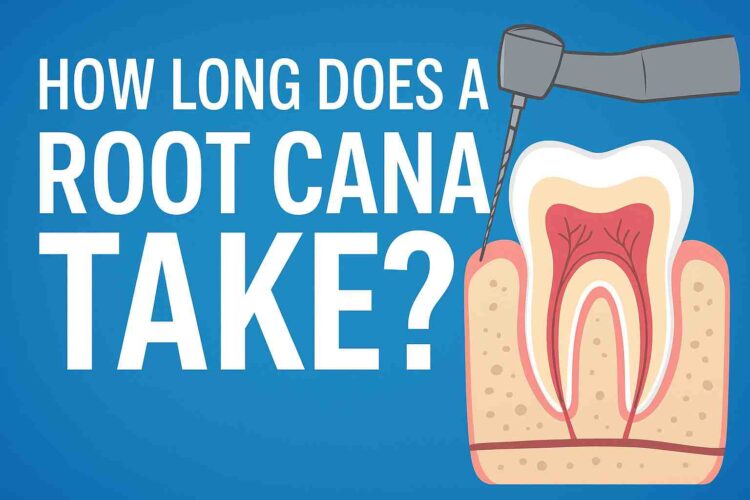A root canal treatment, also known as endodontic therapy, is a dental procedure designed to save a tooth that has become severely decayed, infected, or inflamed. Instead of removing the tooth entirely, a dentist or endodontist removes the infected dental pulp (the soft tissue containing nerves and blood vessels inside the tooth), cleans the canals, and seals them to prevent reinfection.
Many people worry about how long a root canal might take. The truth is, with modern dental technology and anesthesia, it’s often faster and more comfortable than you’d expect. Depending on the tooth type, infection severity, and dentist’s expertise, the procedure usually takes between 30 minutes to 2 hours.
What Happens During a Root Canal Procedure
Understanding the process helps ease anxiety and gives you a sense of how long each part takes. Here’s a simplified step-by-step overview:
-
Diagnosis and X-rays: The dentist takes a digital X-ray or CBCT scan to assess the root structure and infection.
-
Local Anesthesia: The area is numbed with lidocaine or articaine to ensure comfort.
-
Tooth Isolation: A rubber dam is placed to keep the tooth dry and saliva-free.
-
Pulp Removal: The dentist drills a small access hole and removes the infected pulp tissue using endodontic files.
-
Cleaning and Shaping: The root canals are cleaned with disinfectants like sodium hypochlorite and shaped for filling.
-
Filling and Sealing: The canals are sealed with gutta-percha and a dental sealer.
-
Temporary or Permanent Restoration: A temporary filling or dental crown is placed to restore strength and function.
This entire process can be completed in one or two appointments, depending on your case.
Average Time Required for a Root Canal
The average root canal procedure typically lasts between 30 minutes and 2 hours, depending on which tooth is being treated and the complexity of its root structure.
-
Front teeth (incisors and canines): 30–45 minutes
-
Premolars: 45–90 minutes
-
Molars: 90–120 minutes
Molars take the longest because they have three or more root canals compared to a single canal in front teeth.
Factors That Affect Root Canal Duration
1. Type of Tooth
-
Front teeth: Single-root structure = quicker treatment.
-
Molars: Multiple roots and curved canals = longer sessions.
Entity: Tooth anatomy, dental morphology, endodontic canal.
2. Severity of Infection or Damage
-
A mild infection may require one visit.
-
A severe tooth abscess or pulp necrosis can require multiple visits for disinfection.
Entity: Periapical abscess, pulp inflammation, bacterial biofilm.
3. Dentist or Endodontist Expertise
-
A specialist endodontist uses rotary instruments and dental microscopes that make the procedure faster and more precise.
Entity: Rotary endodontics, dental microscope, professional expertise.
4. Dental Equipment and Technology Used
-
Modern clinics use apex locators, laser-assisted irrigation, and digital X-rays, which reduce time and increase success rates.
Entity: Laser dentistry, CBCT imaging, apex locator device.
5. Number of Appointments Needed
-
Single-visit root canals are faster and more convenient.
-
Multi-visit root canals are necessary when infection is severe or complex.
Entity: Temporary filling, calcium hydroxide paste, second appointment.
Single-Visit vs. Multi-Visit Root Canal: What’s Better?
-
Single-Visit Root Canal: Usually takes 60–90 minutes and is ideal for cases with minimal infection.
-
Multi-Visit Root Canal: Involves two or three appointments spaced a few days apart for deep infections or complex tooth anatomy.
Pros of single-visit: Saves time, less anesthesia, immediate relief.
Pros of multi-visit: Better infection control for complicated cases.
Recovery Time After a Root Canal
After your root canal is completed, most patients experience mild tenderness for 1–3 days, which can be managed with ibuprofen or acetaminophen.
You can resume normal activities the same day, though chewing on the treated side should be avoided until the final dental crown is placed.
Full healing of the surrounding tissue may take a few weeks, depending on your body’s response.
When Root Canal Treatment Takes Longer Than Expected
Sometimes, complications can extend the duration of the procedure:
-
Hidden or extra canals not visible on X-ray.
-
Curved or calcified roots that require more shaping time.
-
Re-treatment of a previously failed root canal.
-
Instrument fracture or root perforation that needs correction.
Estimated Time Breakdown for Each Step
| Step | Average Duration | Related Entities |
|---|---|---|
| Dental examination & X-ray | 10–15 min | Dental radiograph, diagnosis |
| Local anesthesia | 5–10 min | Lidocaine, injection |
| Pulp removal & cleaning | 30–60 min | Endodontic files, pulp tissue |
| Canal shaping & irrigation | 15–30 min | Sodium hypochlorite, EDTA |
| Filling & sealing | 15–30 min | Gutta-percha, dental sealer |
| Crown placement | 30–60 min (if same day) | Dental crown, permanent restoration |
Root Canal vs Other Dental Treatments
| Procedure | Typical Duration | Entities |
|---|---|---|
| Tooth filling | 20–30 minutes | Composite resin, cavity |
| Tooth extraction | 20–40 minutes | Oral surgery, local anesthesia |
| Dental implant | 60–120 minutes | Titanium implant, bone graft |
| Root canal | 30–120 minutes | Endodontic therapy, pulp removal |
Root canals take longer because they involve intricate cleaning and sealing of the tooth’s internal structure.
Post-Treatment Care and Instructions
After the procedure:
-
Avoid biting hard foods on the treated tooth for at least 24 hours.
-
Maintain good oral hygiene — brushing twice daily and using an antiseptic mouthwash.
-
Take prescribed antibiotics or painkillers as directed.
-
Return for the permanent crown if a temporary one was placed.
How to Prepare for Your Root Canal Appointment
-
Eat a light meal before your appointment if local anesthesia will be used.
-
Bring headphones or something relaxing to ease anxiety.
-
Discuss sedation dentistry options if you’re nervous.
-
Confirm insurance coverage and post-care instructions in advance.
Frequently Asked Questions (FAQs)
Q1: How long does a root canal take for one tooth?
A: It depends on the tooth. Front teeth take around 30–45 minutes, while molars can take up to two hours.
Q2: Can a root canal be done in one visit?
A: Yes. Many modern endodontists complete root canals in a single 60–90 minute appointment.
Q3: How long does a root canal and crown take together?
A: Around 2–3 hours total if done on the same day.
Q4: Why do molar root canals take longer?
A: Molars have multiple canals and complex root structures that require careful cleaning and sealing.
Q5: How long does pain last after a root canal?
A: Mild discomfort can last 1–3 days. Persistent pain after a week should be checked by your dentist.
Q6: Can I work the same day after a root canal?
A: Yes. Most people return to work immediately, as the local anesthesia wears off within a few hours.
Myths vs Facts About Root Canal Duration
| Myth | Fact |
|---|---|
| Root canals take many hours | Most are done in under 90 minutes |
| All root canals need multiple visits | Many are single-session procedures |
| Recovery is painful and long | Discomfort lasts only a few days |
| Root canals are outdated | Modern techniques are fast and painless |
When to Contact Your Dentist
Contact your dentist or endodontist if:
-
You experience severe pain or swelling after several days.
-
The temporary filling falls out.
-
You notice pus, fever, or a foul taste (signs of infection).
Conclusion — How Long Does a Root Canal Take?
A root canal typically takes 30 minutes to 2 hours, depending on the complexity of the tooth and the expertise of the dental professional. Thanks to advancements in endodontic technology, the treatment is faster, safer, and more comfortable than ever.
If you’re experiencing tooth pain or infection, don’t delay treatment. A timely root canal can save your natural tooth and prevent more costly dental issues later.



Leave Comment